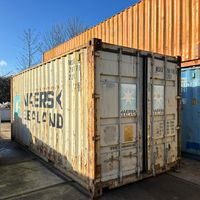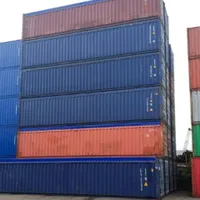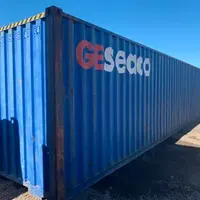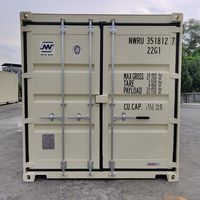Planning your own container logistics chain can get overwhelming. Read this blog to understand the seven steps of container logistics, and how you can simplify them with Container xChange’s logistics solutions.
Shipping containers are the building block of global trade. There’s an entire branch of logistics dedicated to handling the movement of containers. In fact, container logistics is rather complex, consisting of several steps, processes, and paperwork. We’ll look at all of these in detail further in this blog.
But before we deep-dive into container logistics, we can all agree that sourcing containers is the most important step of the process. And if you’re currently looking where to begin your search, we have just the solution for you!
On our online marketplace for containers, you can lease, buy, and sell containers in minutes. Use our trading public search to find a list of container offers by suppliers. Just enter your requirements, and you’ll get a list of wholesale offers in one window. Check it out now!
246 results found on the platform.
Container prices start from $750/unit.
Currently no match for your search
Change your search criteria or fill out the form below to get notified via email when there is a new match for you on xChange!
-
Pick-up

20DC (Wind and water tight)
12 units available
YOM:
Year of manufacture:
2005
2006
Houston, TX
per container
Non-negotiable price$
850
-
Pick-up

20DC (Cargo worthy)
1 unit available
YOM:
Year of manufacture:
2004
2010
Houston, TX
per container
Non-negotiable price$
1050
-
Pick-up

20DC (Cargo worthy)
3 units available
YOM:
Year of manufacture:
2004
2010
Houston, TX
per container
Non-negotiable price$
1050
-
Pick-up

20DC (Cargo worthy)
7 units available
YOM:
Year of manufacture:
2004
2010
Houston, TX
per container
Non-negotiable price$
1100
-
Pick-up

20DC (Brand new)
1 unit available
YOM:
Year of manufacture:
2024
2025
Houston, TX
per container
Negotiable price$
1900
Showing 5 of 246 results
Load more()
YOM:
Year of manufacture:
per container
$
What is Container Logistics?
Container logistics refers to managing, transporting, and coordinating shipping containers as they progress through different phases of the supply chain. Overall, it covers all the steps involved in containerized shipping.
Now that we have that settled, let’s go through the world of container logistics with all its hiccups and rules.
Let’s say you’ve to ship 400 jackets from Shanghai to Los Angeles. Join us on the tour of how we ship these jackets to their destination.
Step 1: Finding container logistics partner
The very first step in planning your container logistics is to reach out to freight forwarders to manage your entire shipping process, including customs clearance, documentation, packaging, and consolidating shipment.
They will also coordinate with carriers like shipping lines and NVOCCs to arrange shipping containers and slot space for your cargo. As a shipper, you can also bring your own containers. But freight forwarders will take charge of planning the entire process from container pickup to delivery.
Also Read: NVOCC vs. Freight Forwarder: Your guide to differences + How to choose
Choosing between COC and SOC containers
The shippers and freight forwarders decide which type of container they want to use. The choice stands between shipper-owned containers (SOCs) and carrier-owned containers (COCs).
The difference between SOCs and COCs is of course the ownership. The carrier-owned containers belong to carriers while shipper-owned containers belong to the shippers. But, this very difference can play a huge role in saving you money during delays and disruptions. Let’s see how you can choose between the two.
To help make this choice, freight forwarders need to figure out what will give the most bang for the buck. And for most export routes, COC containers are the go-to choice. But if you’re shipping to a location with port congestion, SOC containers can be a more cost-efficient method.
In the congestion-prone locations, there are very good chances your containers will get stuck at ships, ports, or depots. If you’re using SOC containers, you’re no longer obliged to pay carriers demurrage and detention charges. This will not only save you loads of money but also give you more flexibility over your shipping process.
But it’s not easy for freight forwarders to find containers on all the routes. This is where we can help you and freight forwarders.
You can easily lease, buy, and sell SOC containers on our online container marketplace. All you’ve to do is enter your requirements such as container type, desired route, and location. And within minutes, you’ll find SOC container offers from verified members. Compare, negotiate, and book your deals— yes, it’s that easy.
Want to see it for yourself? Click on the banner below to see the easiest way of finding SOC containers online.
Buy your own shipping containers as an alternative
Another option to consider when sourcing containers is to buy your own. Owning containers gives you more control over your logistics, especially when facing disruptions or delays. With various container types (standard dry, reefer, flat rack, etc.) and sizes (20ft, 40ft, etc.), you can choose equipment that best fits your cargo needs. Head over to our blog to learn how much different types and sizes of shipping containers cost.
On Container xChange’s online marketplace, you can easily find and buy containers from trusted suppliers at wholesale prices—whether you need them at a specific port, depot, or along your supply chain. With global access to listings, our platform allows you to compare options and buy directly from your computer.
Click on the banner below to learn about out the latest container offers in 2,500+ locations worldwide.
Step 2: Preparing for container transport
Here, at the Chinese factory, you need to get all the jackets loaded into a 40ft container.
When you’re done loading all the jackets in the container, you’ve to secure the container with a container seal. This seals the doors of the container either by cable or bolt. It’s meant to stay on until arrival. A broken seal will show if the container has been opened during transit.
All container seals have an identification number. The numbers must match with the ones on the Bill of Ladings. Otherwise, you can lose valuable time at the port. The customs will hold back the container for inspection over the discrepancy in the documentation.
Now for the container to reach the port, it’ll have to be transported there. How it gets to the port is up to the freight forwarders. Again, it’s all about choosing the best type of container transport for the situation.
In some cases, trucking containers to the port is the smartest. Other times, transporting it by train for certain stretches is faster and more economical.
In the meantime, we’ll explain some of the necessary paperwork for your container.
Step 3: Preparing shipping documents
An important, but not so exciting, part of container logistics is the paperwork. Almost all the parties involved in the transaction will need one or more shipping-related documents.
So, let’s have a look at some of the documents freight forwarders are usually in charge of!
Documents required in container logistics
Commercial Invoice
In international trade, the commercial invoice is one of the most important documents. It serves as a legal document issued by the seller to the buyer. It has the statute of a binding contract and proof of sale. In some cases, the commercial invoice can help you find out if you need an export license.
Certificate of Origin
The Certificate of Origin confirms the country of origin of the freight. This document can be a statement added to the commercial invoice or a certificate on its own. Both should satisfy customs in most countries.
Bill of Lading
Another very important and legally binding document is the Bill of Lading. The Bill of Lading works as a contract of carriage between the shipper and the carrier. It provides the details needed to process the shipment and invoice it correctly. This document must be filled out with the correct information, such as the number on the container seal, otherwise it will serve as a red flag for customs.
Export Packing List
Another vital document is the Export Packing List. It tells in detail about all the products and packaging contained in each shipment. This document isused by parties along the container logistics chain to ensure a smooth shipping process.
There’s a host of customs clearance documents that you should know about. Depending on what commodities you’re shipping and where you’re shipping them to, you might also need documents such as Shipper’s Export Declaration Document and Inspection Certificate.
If all’s well with the documents, your jackets are now aboard a container ship. This leads us to our next step.
Step 4: Unloading and storing containers at the ports
Now, let’s move on to something a bit more exciting! Your container has made the journey from Shanghai to Los Angeles. Your shipment of jackets has finally arrived at the port.
This is the time when the documentation will be checked. And if all’s well, the container will be unloaded from the vessel.
But the not-so-exciting part is the waiting. Due to congestion at ports, your container often gets stuck there for a long time. If you’re using COC containers, your carrier will start levying surcharges after the free days—even before your container has left the port for delivery. This kind of surcharge is referred to as a demurrage charge. And over a period, it can add up to become a huge amount.
We’ve got a solution, of course! You can avoid paying demurrage charges if you’re using SOC containers. Since the containers are not owned by carriers, you’re under no obligation to pay them any fees caused by delays. Now, that’s a relief, right?
Interested in saving money using SOC containers? Click on the banner below to find SOC boxes on your route.
Step 5: Moving containers to their destination
The container waits for a shipping container truck to pick it up. Ideally, you should get your container out of the port as soon as possible. But, that’s hardly the case.
This is where the number of free days you have agreed to in the contract will play a big role. More the number of free days, longer you can store your container at the port without paying per diem charges.
When it’s finally loaded onto the chassisWhat is a chassis? Chassis, in freight & logistics, refers to a skeleton framework with wheels on it used to move containers. It is also called intermodal chassis or container chassis. Similar to ... More and ready to go, the container will head towards the last stop on the tour – the distribution center.
Let’s tag along!
Step 6: Ending your container logistics chain
Your jackets have finally reached the distribution center. Your container will be unloaded from the truck and finally opened. Your jackets are now ready to head to the stores and be sold.
However, often shippers are unable to return the containers in time. If you’re using COC containers, your carrier will start levying surcharges after the free days—for detaining containers outside the port. This kind of surcharge is referred to as a detention charge. And just like demurrage charges, detention charges can add up to a huge amount over a period.
You’re under no obligation to pay detention charges to carriers if you’re using SOC containers.
Want to save money? Click on the banner to find SOC containers for your container logistics leg.
Step 7: Returning the empty container
If you are the SOC owner, you may successfully avoid the detention and demurrage charges but you will still need to cover depot storage and transportation costs for repositioning the container. Empty container repositioning can be costly.
Our container leasing marketplace can help you save big bucks on repositioning. You can make your empty containers available on the marketplace for one-way moves from where the container is to where you want it to be. In our example, it would be back from Los Angeles to Shanghai.
When you list your containers, you can directly connect with businesses that want to use containers on your route, thus reducing repositioning costs. SOC owners can find nearby leasing or selling opportunities, ensuring containers aren’t left idle.
Additionally, xChange offers real-time pricing data, helping owners make informed decisions based on market trends. This approach saves money and improves efficiency in managing empty containers.
Talk to our experts about saving money on empty container repositioning.
Container logistics solutions offered by xChange
Now that you’ve been through the seven steps of container logistics, you’d know that there’s so much more to container logistics than meets the eye. It’s not simple to streamline all the processes of your logistics chain. In fact, it can get really complex, expensive, and time-consuming.
At xChange, we want to simplify the container logistics for all the shipping players globally. We have a range of products and services that helps you plan, operate, and execute your container logistics as smoothly as possible.
Let’s have a quick look at container logistics solutions offered by xChange.
Container leasing
You can lease SOC containers for one-way shipments on xChange. On our online marketplace, you can connect with container suppliers and lessors within minutes. Just enter your pick-up and drop-off locations and container-type to get container offers in 2,500+ locations globally.

Plus, you get complete transparency on pick-up charges, free days, per diem charges, and even performance reviews of all partners in one dashboard. Use this information to choose, negotiate, and book yourself a deal that suits you the best.
Did we tell you that you can avoid empty container repositioning with xChange? Click on the button to learn more about leasing containers.
Container Trading
On our online marketplace, you can find 1,700+ sellers and buyers of containers in 2,500+ locations—all in one dashboard. Just enter your locations and container-type to get container offers globally.
It’s the safest, easiest, and quickest way to connect with genuine partners to buy container-types of your requirement, in your budget.
Did we tell you that you can buy containers on xChange without paying us commission? Click on the button to learn more about buying and selling containers.
Container tracking
Our tracking-dashboard gives you automated alerts for accurate tracking data. You can now update and share ETAsWhat is estimated time of arrival? Estimated time of arrival, commonly known as ETA, is a frequently used term globally to denote the time of coming. In the shipping & logistics industry, it is ... More, wait times, delay warnings or rollovers with your customers.
Use this information to anticipate delays to avoid follow-up costs and disruptions from unforeseen waiting times. Click on the button to get a walkthrough of our container tracking services.
Container price insights
Get real-time container price analytics on xChange. We provide you real-time prices and historical prices, global container price overview, and best buying or selling locations for making informed decisions.
Use our price insights to buy, sell and lease equipment at the best price possible. Click on the button below to know more about our insight services.
Container surveying
You can book equipment surveys in a few clicks on xChange. All you’ve to do is click on the ‘Request Survey’ button on the dashboard to book a survey. Our network of licensed container surveyors in the US will be ready to inspect your boxes.
Did we tell you that our surveying rates are very nominal? Talk to our experts to learn what are the charges for different types of container surveys at your location. Click on the button to start now!
Container insurance
Reduce risk and liability with container insurance on xChange. Our container insurance offers comprehensive coverage for (actual) total loss, constructive total loss, general average and mysterious disappearance.
Want to know the prices on container insurance at xChange? Click on the button to get a full overview of our plans.
Why trust xChange with container logistics?
As you’ve seen, our container logistics solutions are designed to make your job easy. Whether you’re a container supplier, user, freight forwarder, or even a shipping line, our solutions go a long way to simplify the process.
With xChange, you can:
- Reach more people and grow your network.
- Know who you’re doing business with.
- Manage all your transactions in one place – with payment protection.
- Offer sales stock to a global network of 1,700+ certified partners.
- Get notified about the best offers according to your needs.
- Have 100% market visibility and transparency in 2,500+ locations globally.
- All this with no hidden costs.
Want to know how global industry leaders Kuehne + Nagel, Seaco, Conway, Sarjak, and SeaCube are finding value on xChange? Hop on a quick call with our experts to know more about our platform. Get all your doubts resolved and start planning your container logistics chain today!
Plan your Container Logistics with xChange. Contact us!
Frequently Asked Questions (FAQs)
What is container logistics?
Container logistics involves the management, transportation, and coordination of shipping containers through various stages of the supply chain, from origin to destination.
What’s the difference between SOC and COC containers?
Shipper-Owned Containers (SOC) belong to the shipper, while Carrier-Owned Containers (COC) belong to the carrier. SOC containers can save on demurrage and detention charges in case of delays, offering greater flexibility.
How can Container xChange help with container logistics?
Container xChange offers a platform to lease, buy, and sell containers, access real-time tracking and price insights, and manage transactions with a network of global partners, all in one place.
What types of containers can I trade on Container xChange?
You can trade 11+ variety of containers in 20ft, 40ft, 40ft high cube and more container sizes. The platform offers listings from 1,700+ sellers and buyers in over 2,500 global locations.












